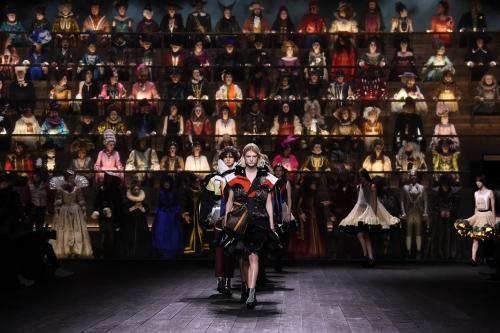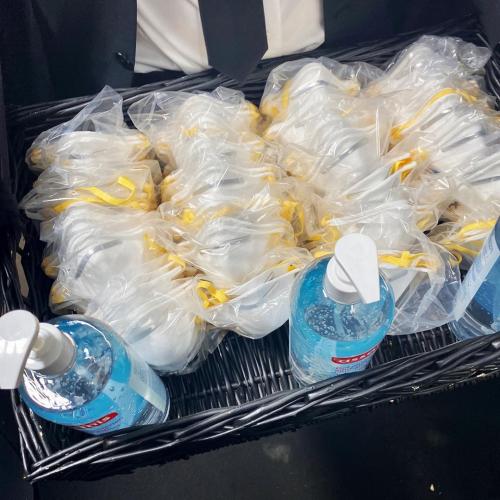
With the coronavirus rapidly spreading, our awareness of how industries are being affected on a large-scale has dramatically increased. Between Milan and Paris Fashion Week the number of cases has surged and, more significantly, the already growing anxiety has exploded. People have begun to take the virus seriously, perceiving a threat instead of feeling protected by geographical distance in the Western world. The effects thereof can be seen clearly. In the penultimate show of the fashion month, Lacoste, between 20 and 30 percent of the guests failed to show up. Whether or not the coronavirus itself is as severe as the media is leading us to believe, the effects within the fashion industry are substantial.
Rakuten Fashion Week has been cancelled, some design houses responded by handing out masks before their shows, several buyers (whom fashion shows are economically targeted at) decided not to come at all. Japan’s biggest fashion festival, the Tokyo Girls Collection, was held in an empty hall causing 12,000 tickets to be refunded and the runway show to be livestreamed instead: a dystopian image of an empty stage that exemplifies the mounting fear. These effects demonstrate how rapidly industries manage to adapt in changing times, however they are equally indicative of the large drop in the demand that keeps the fashion industry alive. Fashion weeks exist to showcase emerging designers and new collections with the intention to sell. If this crucial step of the industry’s mechanism does not occur, the entire process comes to a halt: the demand-side issues provoke a problem for designers, who are incapable of reaching their target audience, whilst producers don’t find an outlet for their products. The fashion market seems like a ghost-town, as all participants have escaped into hiding.

Yet, the issues don’t only occur on the demand-side. As workers are being kept home in China, delays in the clothing supply chain are mounting, as many items are produced there – the country with the most cases of the coronavirus. Clothing collections cannot simply be postponed but need to be sold when appropriate, as the fashion industry works in strict seasons. The entire system may potentially be disrupted, showing just how deeply the economic stagnancy affects the fashion industry.
Of the estimated $305 billion spent on luxury goods 2019, Chinese buyers constitute around 40%. Hence, the existing and possibly continuing travel bans are risking a reduction of global spending, putting a strain on designers, retailers, producers – this can be felt in the stock market. The average consumer simply won’t be in the mood for fashion, as even the fashion centres of Milan and Paris redirect their attention towards damage control, away from leisurely consumption.
As a result, the French luxury conglomerate cooperation LVMH’s stocks have been falling over the last month, dropping from a share value of 92.66 USD at close on 12th Feb to 78.61 USD at close on March 10th. The drop is partially caused by a personal change in priorities, as consumers choose health products over luxury items in the perceived crisis. The fear is seemingly justified when brands such as Ralph Lauren, Gucci or Prada cancel their shows, apparently confirming the fear that the fashion industry is suffering under the strain of COVID-19. Perhaps optimistically speaking, on an economic level it may be assumed that the volatilities of the stocks will experience a rapid recovery just as they have experienced the abrupt drop. People will hopefully return to their normal consumption habits, as even this outbreak becomes ‘normal’ and daily life continues.
“At a time of crisis, we have to think about a radical reset”
Regardless of the recovery that may be anticipated for the future, the most significant effect occurs within the production industries. The Chinese workforce is banned from work, which we only perceive through the reduced supply that puts a strain on the fashion industry and the global economy. Meanwhile, for the workers the ongoing stagnancy of the Chinese output will raise questions about future income in a weakening economy, posing difficulty for firms that may question how to make up the economic losses. Especially due to the destabilised economy, this may lead to lower incomes – a disastrous outcome in a country that bases its economic model on already low labour costs, especially in the production of clothing.
These demand-side and supply-side issues reveal underlying institutional problems. In light of the cancellation of many shows, Anna Wintour spoke out about whether these wasteful, expensive events are still necessary in our changing times. “At a time of crisis, we have to think about a radical reset”, she said, capturing the need for reform in all sectors of the industry, even those that are usually silently concealed.
Perhaps, this shows that the danger within this situation is not primarily the virus, but what that has revealed about our social, moral and economic character. Consumers are focused on the next collection, the industry is focused on grand events to promote brands and individuals, whilst the production sector focuses on profit. Especially within the fashion industry, the coronavirus should allow us to reconsider what we perceive as normal, even after the immediate danger seems to have passed.
[“source=varsity”]